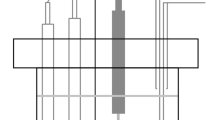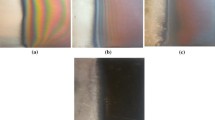Abstract
The comparison of different grades of carbon steel (API 5L X52 and X60) dissolution in CO2–H2S solution at various acetic acid concentrations was investigated via electrochemical experiments and other complementary techniques such as FESEM, XPS and contact angle measurements. The results are evident to suggest that the carbon steel grade strongly influences corrosion rate as X60 corrodes more than X52 in the system being investigated. The possible mechanism behind the higher corrosion rate observed for X60 is elucidated via analyzing the impedance data acquired at various overpotentials by the reaction mechanism analysis approach. The kinetics of dissolution in the given medium for the carbon steels is also reported. It is observed that X52 possess higher surface energy (lower contact angle), which eventually increases the formation rate of FeCO3 on X52. The FeCO3 layer formed on X52 is fine in nature, acts as a protective layer and decreases the corrosion rate.




















Similar content being viewed by others
References
Ochoa, N.; Vega, C.; Pébère, N.; Lacaze, J.; Brito, J.L.: CO2 corrosion resistance of carbon steel in relation with microstructure changes. Mater. Chem. Phys. 156, 198–205 (2015). https://doi.org/10.1016/j.matchemphys.2015.02.047
Santos, B.A.F.; Souza, R.C.; Serenario, M.E.D.; Mendes Junior, E.P.; Simões, T.A.; de Oliveira, J.R.; Vaz, G.L.; Caldeira, L.; da Cunha Ponciano Gomes, J.A.; Bueno, A.H.S.: The role of acetic acid in FeCO3 scale deposition on CO2 corrosion of API X65 carbon steel under high temperatures. Corros. Eng. Sci. Technol. 56, 553–564 (2021). https://doi.org/10.1080/1478422X.2021.1920171
Zhang, S.; Li, Y.; Liu, B.; Mou, L.; Yu, S.; Zhang, Y.; Yan, X.: Understanding the synergistic effect of CO2, H2S and fluid flow towards carbon steel corrosion. Vacuum 196, 110790 (2022). https://doi.org/10.1016/j.vacuum.2021.110790
Rustandi, A.; Adhika, N.; Prima, T.; Aziz, N.: Behavior of CO2 corrosion of API 5L X52 steel in NaCl solution under turbulent flow condition. Adv. Mater. Res. 789, 476–483 (2013). https://doi.org/10.4028/www.scientific.net/AMR.789.476
George, K.S.; Nešic, S.: Investigation of carbon dioxide corrosion of mild steel in the presence of acetic acid—Part 1: basic mechanisms. Corrosion 63, 178–186 (2007). https://doi.org/10.5006/1.3278342
Li, S.; Zeng, Z.; Harris, M.A.; Sánchez, L.J.; Cong, H.: CO2 corrosion of low carbon steel under the joint effects of time-temperature-salt concentration. Front. Mater. 6, 1–17 (2019). https://doi.org/10.3389/fmats.2019.00010
Kermani, M.B.; Morshed, A.: Carbon dioxide corrosion in oil and gas production—a compendium. Corrosion 59, 659–683 (2003). https://doi.org/10.5006/1.3277596
Liu, M.; Wang, J.; Ke, W.: Corrosion behaviour of X52 pipeline steel in high H2S concentration solutions at temperatures ranging from 25°C to 140°C. Corros. Eng. Sci. Technol. 48, 380–387 (2013). https://doi.org/10.1179/1743278213Y.0000000095
Hernández-Espejel, A.; Domínguez-Crespo, M.A.; Cabrera-Sierra, R.; Rodríguez-Meneses, C.; Arce-Estrada, E.M.: Investigations of corrosion films formed on API-X52 pipeline steel in acid sour media. Corros. Sci. 52, 2258–2267 (2010). https://doi.org/10.1016/j.corsci.2010.04.003
Qin, M.; Liao, K.; He, G.; Zou, Q.; Zhao, S.; Zhang, S.: Corrosion mechanism of X65 steel exposed to H2S/CO2 brine and H2S/CO2 vapor corrosion environments. J. Nat. Gas Sci. Eng. 106, 104774 (2022). https://doi.org/10.1016/j.jngse.2022.104774
Gao, S.; Brown, B.; Young, D.; Nesic, N.; Singer, M.: Formation mechanisms of iron oxide and iron sulfide at high temperature in aqueous H2S corrosion environment. J. Electrochem. Soc. 165, 171–179 (2018). https://doi.org/10.1149/2.0921803jes
Asadian, M.; Sabzi, M.; Anijdan, S.H.M.: The effect of temperature, CO2, H2S gases and the resultant iron carbonate and iron sulfide compounds on the sour corrosion behaviour of ASTM A-106 steel for pipeline transportation. Int. J. Press. Vessel. Pip. 171, 184–193 (2019). https://doi.org/10.1016/j.ijpvp.2019.02.019
Li, D.P.; Zhang, L.; Yang, J.W.; Lu, M.X.; Ding, J.H.; Liu, M.L.: Effect of H2S concentration on the corrosion behavior of pipeline steel under the coexistence of H2S and CO2. Int. J. Miner. Metall. Mater. 21, 388–394 (2014). https://doi.org/10.1007/s12613-014-0920-y
Zou, Q.; Liao, K.; Leng, J.; Zhao, S.; He, G.; Zhou, F.; Pu, C.: Corrosion mechanism of oil field gathering pipeline containing small H2S impurity. Arab. J. Sci. Eng. 47, 12075–12087 (2022). https://doi.org/10.1007/s13369-022-06867-6
Souza, R.C.; Santos, B.A.F.; Gonçalves, M.C.; Mendes Júnior, E.P.; Simões, T.A.; Oliveira, J.R.; Vaz, G.L.; Caldeira, L.; Gomes, J.A.C.P.; Bueno, A.H.: The role of temperature and H2S (thiosulfate) on the corrosion products of API X65 carbon steel exposed to sweet environment. J. Pet. Sci. Eng. 180, 78–88 (2019). https://doi.org/10.1016/j.petrol.2019.05.036
Qi, Y.; Luo, H.; Zheng, S.; Chen, C.; Lv, Z.; Xiong, M.: Effect of temperature on the corrosion behavior of carbon steel in hydrogen sulphide environments. Int. J. Electrochem. Sci. 9, 2101–2112 (2014)
Madani Sani, F.; Brown, B.; Nesic, S.: An electrochemical study of the effect of high salt concentration on uniform corrosion of carbon steel in aqueous CO2 solutions. J. Electrochem. Soc. 168, 051501 (2021). https://doi.org/10.1149/1945-7111/abf5f9
Liu, H.; Fu, C.; Gu, T.; Zhang, G.; Lv, Y.; Wang, H.; Liu, H.: Corrosion behavior of carbon steel in the presence of sulfate reducing bacteria and iron oxidizing bacteria cultured in oilfield produced water. Corros. Sci. 100, 484–495 (2015). https://doi.org/10.1016/j.corsci.2015.08.023
Talukdar, A.; Baranwal, P.K.; Talukdar, M.K.; Rajaraman, P.V.: Synergistic effect of H2S and acetic acid on CO2 corrosion of carbon steel at elevated temperature. JOM 75, 3757–3770 (2023). https://doi.org/10.1007/s11837-023-05952-x
Kahyarian, A.; Brown, B.; Nešić, S.: Mechanism of cathodic reactions in acetic acid corrosion of iron and mild steel. Corrosion 72, 1539–1546 (2016)
Tran, T.; Brown, B.; Nesic, S.; Tribollet, B.: Investigation of the mechanism for acetic acid corrosion of mild steel. NACE Int. Corros. Conf. Ser. 70, 1–12 (2013)
Tran, T.; Brown, B.; Nešić, S.; Tribollet, B.: Investigation of the electrochemical mechanisms for acetic acid corrosion of mild steel. Corrosion 70, 223–229 (2014). https://doi.org/10.5006/0933
Dhongde, V.; Velpandian, M.; Haider, M.A.; Basu, S.: A Sr2CoNbO6-δ@Sm0.2Ce0.8O2-δ nanofiber composite as cathode accelerates oxygen reduction reaction for IT-SOFC to. ECS Trans. 111, 2271–2276 (2023). https://doi.org/10.1149/11106.2271ecst
Singh, M.M.; Gupta, A.: Corrosion behavior of mild steel in acetic acid solutions. Corrosion 56, 371–379 (2000)
Talukdar, A.; Rajaraman, P.V.: Investigation of acetic acid effect on carbon steel corrosion in CO2–H2S medium: mechanistic reaction pathway and kinetics. ACS Omega 5, 11378–11388 (2020). https://doi.org/10.1021/acsomega.0c00387
Dhongde, N.R.; Baranwal, P.K.; Rajaraman, P.V.: Functionalization of graphene oxide with an ionic liquid (1-butyl-3-methylimidazolium acetate): preparation of epoxy-based coating on carbon steel for anticorrosive applications. J. Appl. Polym. Sci. (2023). https://doi.org/10.1002/app.54026
Khan, H.M.; Özer, G.; Yilmaz, M.S.; Koc, E.: Corrosion of additively manufactured metallic components: a review. Arab. J. Sci. Eng. 47, 5465–5490 (2022). https://doi.org/10.1007/s13369-021-06481-y
Karimi Abadeh, H.; Javidi, M.: Assessment and influence of temperature, NaCl and H2S on CO2 corrosion behavior of different microstructures of API 5L X52 carbon steel in aqueous environments. J. Nat. Gas Sci. Eng. 67, 93–107 (2019). https://doi.org/10.1016/j.jngse.2019.04.023
Zhang, L.; Yang, J.; Sun, J.; Lu, M.: Effect of pressure on wet H2S/CO2 corrosion of pipeline steel. NACE Int. Corros. Conf. Ser., pp. 1–9 (2009)
Kahyarian, A.; Schumaker, A.; Brown, B.; Nesic, S.: Acidic corrosion of mild steel in the presence of acetic acid: mechanism and prediction. Electrochim. Acta 258, 639–652 (2017). https://doi.org/10.1016/j.electacta.2017.11.109
Rihan, R.O.: Electrochemical corrosion behavior of X52 and X60 steels in carbon dioxide containing saltwater solution. Mater. Res. 16, 227–236 (2013). https://doi.org/10.1590/S1516-14392012005000170
Keddam, M.; Mattos, O.R.; Takenouti, H.: Reaction model for iron dissolution studied by electrode impedance: II. Determination of the reaction model. J. Electrochem. Soc. 128, 266–274 (1981). https://doi.org/10.1149/1.2127402
Folena, M.C.; Ponciano, J.A.C.: Assessment of hydrogen embrittlement severity of an API 5LX80 steel in H2S environments by integrated methodologies. Eng. Fail. Anal. 111, 104380 (2020). https://doi.org/10.1016/j.engfailanal.2020.104380
Kappes, M.; Frankel, G.S.; Sridhar, N.; Carranza, R.M.: Reaction paths of thiosulfate during corrosion of carbon steel in acidified brines. J. Electrochem. Soc. 159, C195–C204 (2012). https://doi.org/10.1149/2.085204jes
Vivier, V.; Orazem, M.E.: Impedance analysis of electrochemical systems. Chem. Rev. 122, 11131–11168 (2022). https://doi.org/10.1021/acs.chemrev.1c00876
Perez, N.: Electrochemistry and Corrosion Science. Springer, Berlin (2004)
Zhang, L.; Zhong, W.; Yang, J.; Gu, T.: Effects of temperature and partial pressure on H2S/CO2 corrosion of pipeline steel in sour conditions. NACE Int. Corros. Conf. Ser. NACE-11079 (2011)
Instruments, G.: Basics of Electrochemical Impedance Spectroscopy. https://scholar.google.co.in/scholar?q=basics+of+electrochemical+impedance+spectroscopy&hl=en&as_sdt=0&as_vis=1&oi=scholart
Kumar, A.; Das, C.: A novel eco-friendly inhibitor of chayote fruit extract for mild steel corrosion in 1 M HCl: electrochemical, weight loss studies, and the effect of temperature. Sustain. Chem. Pharm. 36, 101261 (2023). https://doi.org/10.1016/j.scp.2023.101261
Amrutha, M.S.; Rao, M.T.; Ramanathan, S.: Mechanistic analysis of anodic dissolution of Zr in acidic fluoride media. J. Electrochem. Soc. 165, C162–C170 (2018). https://doi.org/10.1149/2.0851803jes
Akeer, E.; Brown, B.; Nesic, S.: The influence of mild steel metallurgy on the initiation of localized CO2 corrosion in flowing conditions. NACE Int. Corros. Conf. Ser., pp. 1–16 (2013)
Calan-Canche, D.; García-Hernández, R.; Dzib-Pérez, L.; Bilyy, O.L.; González-Sánchez, J.: Susceptibility to the absorption of atomic hydrogen in API 5L X60 steels with unconventional heat treatment. Mater. Sci. 54, 573–581 (2019). https://doi.org/10.1007/s11003-019-00220-3
López, D.A.; Schreiner, W.H.; De Sánchez, S.R.; Simison, S.N.: The influence of carbon steel microstructure on corrosion layers: an XPS and SEM characterization. Appl. Surf. Sci. 207, 69–85 (2003). https://doi.org/10.1016/S0169-4332(02)01218-7
Alam, M.T.; Chan, E.W.L.; De Marco, R.; Huang, Y.; Bailey, S.: Electrochemical and surface analysis studies on the carbon dioxide corrosion of X-65 carbon steel. Electroanalysis 28, 2910–2921 (2016). https://doi.org/10.1002/elan.201600309
Wang, L.; Wang, H.; Seyeux, A.; Zanna, S.; Pailleret, A.; Nesic, S.; Marcus, P.: Adsorption mechanism of quaternary ammonium corrosion inhibitor on carbon steel surface using ToF-SIMS and XPS. Corros. Sci. 213, 110952 (2023). https://doi.org/10.1016/j.corsci.2022.110952
Singh, A.; Ansari, K.R.; Chauhan, D.S.; Quraishi, M.A.; Lgaz, H.; Chung, I.M.: Comprehensive investigation of steel corrosion inhibition at macro/micro level by ecofriendly green corrosion inhibitor in 15% HCl medium. J. Colloid Interface Sci. 560, 225–236 (2020). https://doi.org/10.1016/j.jcis.2019.10.040
Behera, S.K.; Kumar, P.A.; Dogra, N.; Nosonovsky, M.; Rohatgi, P.: Effect of microstructure on contact angle and corrosion of ductile iron: iron-graphite composite. Langmuir 35, 16120–16129 (2019). https://doi.org/10.1021/acs.langmuir.9b02395
Wei, L.; Pang, X.; Gao, K.: Effect of small amount of H2S on the corrosion behavior of carbon steel in the dynamic supercritical CO2 environments. Corros. Sci. 103, 132–144 (2016). https://doi.org/10.1016/j.corsci.2015.11.009
Choi, Y.S.; Nesic, S.; Ling, S.: Effect of H2S on the CO2 corrosion of carbon steel in acidic solutions. Electrochim. Acta 56, 1752–1760 (2011). https://doi.org/10.1016/j.electacta.2010.08.049
Liu, Z.; Gao, X.; Du, L.; Li, J.; Li, P.; Yu, C.; Misra, R.D.K.; Wang, Y.: Comparison of corrosion behaviour of low-alloy pipeline steel exposed to H2S/CO2-saturated brine and vapour-saturated H2S/CO2 environments. Electrochim. Acta 232, 528–541 (2017). https://doi.org/10.1016/j.electacta.2017.02.114
Acknowledgements
The authors appreciate IEOT, ONGC, Panvel, Navy Mumbai for the financial assistance, Central Instruments Facility (CIF) of the Indian Institute of Technology (IIT) Guwahati for providing analytical facilities, and Aries Engineer, Maharashtra, India for metal fabrication.
Author information
Authors and Affiliations
Corresponding author
Ethics declarations
Conflict of interst
The authors declare that they have no known competing financial interests or personal relationships that could have appeared to influence the work reported in this paper.
Supplementary Information
Below is the link to the electronic supplementary material.
Rights and permissions
Springer Nature or its licensor (e.g. a society or other partner) holds exclusive rights to this article under a publishing agreement with the author(s) or other rightsholder(s); author self-archiving of the accepted manuscript version of this article is solely governed by the terms of such publishing agreement and applicable law.
About this article
Cite this article
Adhikari, S., Dhongde, N.R., Talukdar, M.K. et al. Investigation of Carbon Steels (API 5L X52 and API 5L X60) Dissolution CO2–H2S Solutions in the Presence of Acetic Acid: Mechanistic Reaction Pathway and Kinetics. Arab J Sci Eng 49, 8363–8381 (2024). https://doi.org/10.1007/s13369-024-08812-1
Received:
Accepted:
Published:
Issue Date:
DOI: https://doi.org/10.1007/s13369-024-08812-1




